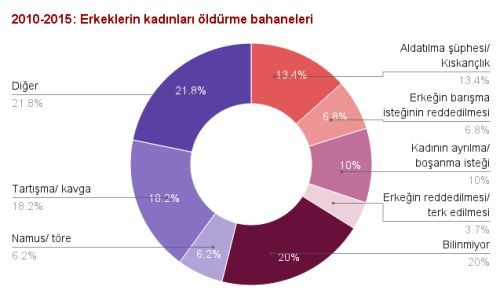“Kadın cinayetlerinin önüne geçmenin yolu bu verilerde”
2010-2015 yılları arasında en az 1134 kadının erkekler tarafından öldürüldüğü Türkiye’de, ‘saçını kızıla boyatmak’, ‘yeni elbise almak’, ‘patates köfte yapmamak’, ‘tuzluğu uzatmamak’ veya sadece ‘gıcık olmak’ dahi bir kadın cinayetinin bahanesi olabildi. Failler ise koca, sevgili, baba, oğul, erkek kardeş, kısaca kadınların en yakınındaki erkekler...


Ceyda Ulukaya’nın, Bianet.org’un ‘Erkek Şiddeti Çetelesi’ verilerini temel alarak hazırladığı ‘kadıncinayetleri.org’ sitesi, 25 Kasım Kadına Yönelik Şiddete Karşı Uluslararası Mücadele Günü’nden önce yayınlandı. Sitede, Türkiye’de 2010- 2015 yılları arasında işlenen kadın cinayetlerinin il ve ilçelere dağılımını harita üzerinde görülebilirken, veri tabanından kadın cinayetlerinin faillerine, faillerin bahanelerine ve cinayetlerle ilgili tüm detaylara ulaşılabiliyor.
Haritalandırma projesinin amacını kısaca anlatabilir misiniz?
Her gün cinayetler oluyor, türlü bahanelerle kadınlar öldürülüyor. Ama sonra gündem akışında kaybolup gidiyor. Sonrasında ancak bir rakam olarak hatırlıyoruz bu cinayetleri. Ama bu kadınların nasıl öldüğüne dair bilinmesi gerekenler var: Ne bahanelerle öldürüldüler, cinayet öncesinde şiddet veya tehdit aldılar mı, korunma amaçlı bir başvuruda bulundular mı? Bu ayrıntıların hepsinin bir arada bulunduğu, kadın cinayetlerine dair bir veri tabanı oluşturmayı amaçladık.

Burada da aslında dikkat çeken rakamların olduğunu görüyoruz.
Evet, 1134 kadından 608'inin kocası veya eski kocası tarafından öldürüldüğünü söylüyoruz. 161 kadının da faili erkek arkadaşı veya eski erkek arkadaşı. Dolayısıyla failler kadınların hayatlarındaki erkekler ağırlıklı olarak. Bu büyük tablodan çıkardığımız sonuç, kadınların 217'si cinayet öncesi sistematik şiddet veya tacize maruz kalmış. Cinayetlerin 141'i resmi kurumlara başvurulduğu halde işlenmiş ki bunun içinde karakola gidip şikâyette bulunmak da var, savcılığa şikâyet etmek de var, korunma talebi de var, sığınma evi başvurusu da var. Bu 141 kadın en az bir kere bu kurumlara başvurduğu halde öldürüldüler. 234 cinayet de devam eden bir ayrılık veya boşanma sürecinde yaşandı.
Zaten ‘bahaneler’ başlığı altında da ayrıntılı inceleme yapıyorsunuz.
Bahaneler kısmı incelendiğinde görüyoruz ki kadının boşanma veya ayrılık isteği de birçok cinayette bahane olarak kullanılmış. Bunların dışında tabii gündelik hayata ilişkin çok daha absürd bahaneler de var. Mesela kadının patates köfte yapmamış olması veya ufak bir mevzudaki fikir ayrılığı, hatta cinayet işledikten sonra sadece “Gıcık oldum” deme fütursuzluğunu gösterebilenler bile var. Veya herhangi bir sebep belirtmeden, “Sebebi yok, yine de öldürdüm” diyen erkekler var. “Öyle öldürdüm işte”, bu kadar basit aslında kadının hayatını sonlandırma hakkını kendinde görme gerekçesi, bu kadar kolay olabiliyor. Dolayısıyla bu site aslında bütün bu verileri ayrıntılı bir şekilde görmeyi sağlamak ve cinayetlerin önlenmesi konusunda aslında ne yönde tedbirler alınmalı, bunların ne kadarı alındı, alınıyor veya alınmak isteniyor, işte bunları biraz daha somut olarak göstermek amacıyla hazırlandı.
 Neden ‘cinayet sebebi’ ifadesi yerine ‘bahane’ kelimesi tercih ettiniz?
Neden ‘cinayet sebebi’ ifadesi yerine ‘bahane’ kelimesi tercih ettiniz?
Aslında bu tercihin nedeni medyada… Kadincinayetleri.org’da kaynak olarak gösterdiğimiz haberlerde de görülebilir. Hep üçüncü sayfa haberleri bunlar, cinayetleri birer adli vaka, bir olay olarak görmek ve ötesini deşmemekten ibaret. Gazetelerin üçüncü sayfalarının mantığı ve kendisi her ne kadar bu çerçevede olsa da, dikkat çekilmesi gereken nokta bu cinayetlerin aslında sistematik bir boyutu olduğu… Medyanın kadın cinayetlerini ele alış biçimi maalesef çok sorunlu. Tamamen cinayeti işleyen erkeğin ifadelerine dayanıyor. Ama bu olayların çok farklı zemin ve boyutlarda ele alınılması gerekir. İlk etapta bunlar üçüncü sayfadan çıkmalı. Kadının hak arayışını yansıtan, bu cinayetlerin önlenmesine yönelik politikaların ne yönde oluşturulduğunu sorgulayan, cinayetlerin neden gerçekleştiğini ve nasıl engellenebileceğini yansıtan şekilde haberlerin yazılması gerekiyor. Medyaya yansıyan boyutuyla ele almak zorunda olduğumuz için söz konusu haberleri kaynak aldık ama haberlerin küçük birer özetini de bizzat yazdım ve oradaki dile de dikkat ederek, mesela kadın dayak yedi demek yerine kadın şiddet gördü demek gibi, kullanılan dil bile başlı başına aslında bir farkı ortaya koyuyor.
Sonraki etapta proje çerçevesinde ne yapmayı düşünüyorsunuz?
Sitede henüz 2015 verileri mevcut olmadığı için en kısa sürede onlar dâhil edilecek. Daha sonra site her ay güncellenen bir görünüme kavuşacak. Bianet.org her ay ‘Erkek Şiddeti Çetelesi’ verilerini yayınladıkça, ilgili veriler kadincinayetleri.org sitesinin veri tabanına aktarılacak ve tabii ki veriler de haritaya yansıyacak.
Haritalandırma projesinin amacını kısaca anlatabilir misiniz?
Her gün cinayetler oluyor, türlü bahanelerle kadınlar öldürülüyor. Ama sonra gündem akışında kaybolup gidiyor. Sonrasında ancak bir rakam olarak hatırlıyoruz bu cinayetleri. Ama bu kadınların nasıl öldüğüne dair bilinmesi gerekenler var: Ne bahanelerle öldürüldüler, cinayet öncesinde şiddet veya tehdit aldılar mı, korunma amaçlı bir başvuruda bulundular mı? Bu ayrıntıların hepsinin bir arada bulunduğu, kadın cinayetlerine dair bir veri tabanı oluşturmayı amaçladık.

Burada da aslında dikkat çeken rakamların olduğunu görüyoruz.
Evet, 1134 kadından 608'inin kocası veya eski kocası tarafından öldürüldüğünü söylüyoruz. 161 kadının da faili erkek arkadaşı veya eski erkek arkadaşı. Dolayısıyla failler kadınların hayatlarındaki erkekler ağırlıklı olarak. Bu büyük tablodan çıkardığımız sonuç, kadınların 217'si cinayet öncesi sistematik şiddet veya tacize maruz kalmış. Cinayetlerin 141'i resmi kurumlara başvurulduğu halde işlenmiş ki bunun içinde karakola gidip şikâyette bulunmak da var, savcılığa şikâyet etmek de var, korunma talebi de var, sığınma evi başvurusu da var. Bu 141 kadın en az bir kere bu kurumlara başvurduğu halde öldürüldüler. 234 cinayet de devam eden bir ayrılık veya boşanma sürecinde yaşandı.
Zaten ‘bahaneler’ başlığı altında da ayrıntılı inceleme yapıyorsunuz.
Bahaneler kısmı incelendiğinde görüyoruz ki kadının boşanma veya ayrılık isteği de birçok cinayette bahane olarak kullanılmış. Bunların dışında tabii gündelik hayata ilişkin çok daha absürd bahaneler de var. Mesela kadının patates köfte yapmamış olması veya ufak bir mevzudaki fikir ayrılığı, hatta cinayet işledikten sonra sadece “Gıcık oldum” deme fütursuzluğunu gösterebilenler bile var. Veya herhangi bir sebep belirtmeden, “Sebebi yok, yine de öldürdüm” diyen erkekler var. “Öyle öldürdüm işte”, bu kadar basit aslında kadının hayatını sonlandırma hakkını kendinde görme gerekçesi, bu kadar kolay olabiliyor. Dolayısıyla bu site aslında bütün bu verileri ayrıntılı bir şekilde görmeyi sağlamak ve cinayetlerin önlenmesi konusunda aslında ne yönde tedbirler alınmalı, bunların ne kadarı alındı, alınıyor veya alınmak isteniyor, işte bunları biraz daha somut olarak göstermek amacıyla hazırlandı.
 Neden ‘cinayet sebebi’ ifadesi yerine ‘bahane’ kelimesi tercih ettiniz?
Neden ‘cinayet sebebi’ ifadesi yerine ‘bahane’ kelimesi tercih ettiniz?Aslında bu tercihin nedeni medyada… Kadincinayetleri.org’da kaynak olarak gösterdiğimiz haberlerde de görülebilir. Hep üçüncü sayfa haberleri bunlar, cinayetleri birer adli vaka, bir olay olarak görmek ve ötesini deşmemekten ibaret. Gazetelerin üçüncü sayfalarının mantığı ve kendisi her ne kadar bu çerçevede olsa da, dikkat çekilmesi gereken nokta bu cinayetlerin aslında sistematik bir boyutu olduğu… Medyanın kadın cinayetlerini ele alış biçimi maalesef çok sorunlu. Tamamen cinayeti işleyen erkeğin ifadelerine dayanıyor. Ama bu olayların çok farklı zemin ve boyutlarda ele alınılması gerekir. İlk etapta bunlar üçüncü sayfadan çıkmalı. Kadının hak arayışını yansıtan, bu cinayetlerin önlenmesine yönelik politikaların ne yönde oluşturulduğunu sorgulayan, cinayetlerin neden gerçekleştiğini ve nasıl engellenebileceğini yansıtan şekilde haberlerin yazılması gerekiyor. Medyaya yansıyan boyutuyla ele almak zorunda olduğumuz için söz konusu haberleri kaynak aldık ama haberlerin küçük birer özetini de bizzat yazdım ve oradaki dile de dikkat ederek, mesela kadın dayak yedi demek yerine kadın şiddet gördü demek gibi, kullanılan dil bile başlı başına aslında bir farkı ortaya koyuyor.
Sonraki etapta proje çerçevesinde ne yapmayı düşünüyorsunuz?
Sitede henüz 2015 verileri mevcut olmadığı için en kısa sürede onlar dâhil edilecek. Daha sonra site her ay güncellenen bir görünüme kavuşacak. Bianet.org her ay ‘Erkek Şiddeti Çetelesi’ verilerini yayınladıkça, ilgili veriler kadincinayetleri.org sitesinin veri tabanına aktarılacak ve tabii ki veriler de haritaya yansıyacak.


